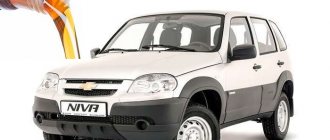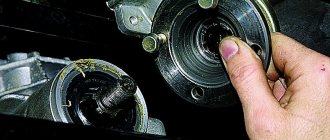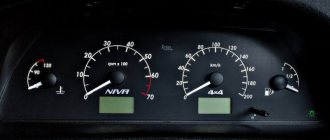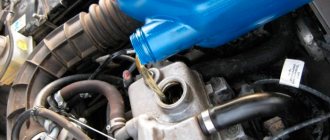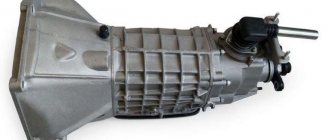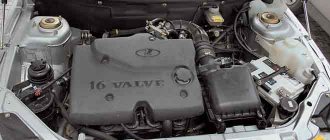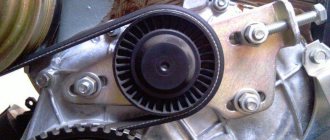The Niva SUV, in all modifications, is very popular in Russian spaces. This is due to good maintainability, low price and excellent maneuverability. To ensure reliable operation, you should undergo all maintenance on time, in particular, change the engine oil.
The VAZ 21214 engine lubrication system is designed to protect against premature wear of moving parts. It completely copes with its task, you just need to follow all the manufacturer’s recommendations.
Purpose and types of engine oil filter
The main function that the filter element performs is to clean the car engine from various particles (dust, metal, etc.). Small particles can enter the engine from the environment through the air or fuel elements. This is an important, but not the only function of the cleaning element. The filter, together with motor lubricant, performs the following number of functions:
- Removing heat from rubbing engine parts;
- Creating a film between rubbing parts that prevents them from abrasion;
- Reducing the noise level that occurs during friction of parts.
There are three types of filters:
- with full flow;
- with partial flow;
- with combined flow.
To find out which filter is considered the best, let's briefly consider the purpose of each.
Structure of a car oil filter
Full flow conducts the main flow of oil through its cleaning elements, which moves from the oil pump. After which, the already purified composition is supplied to all components and assemblies of the engine. In addition to the cleaning element, the full-flow oil filter has a valve in its design. The valve is designed to regulate the pressure in the system. This valve prevents a decrease in pressure, which creates a risk of damage to seals and rubbing parts. When the cleaning element becomes clogged, the valve opens and allows oil and contaminants to enter the engine. Thus, serious damage to engine parts is prevented, but the filter allows uncleaned oil to pass through.
Partial capacity filters differ in the quality of cleaning from the previous type. But this quality affects the duration of the cleaning process. Cleaning takes much longer, but with less risk of pressure loss in the system if the filter is clogged.
Used (operating) fluids and filling volumes
FILLING CAPACITIES
| Refillable system | Volume, l |
| Fuel tank (including reserve) | 42 (65*) |
| Engine cooling system (including interior heating system) | 10,7 |
| Engine lubrication system (including oil filter) | 3,75 |
| Gearbox housing | 1,6 |
| Rear axle housing | 1,3 |
| Steering gear housing | 0,18 |
| Transfer case housing | 0,79 |
| Front axle housing | 1,15 |
| Hydraulic clutch system | 0,2 |
| Hydraulic brake system | 0,535 |
| Windshield and headlight washer reservoir | 2,8 |
| Rear window washer reservoir | 2,0 |
| Power steering reservoir | 1,7 |
* For VAZ-2131 cars and its modifications.
| Refueling or lubrication point | Quantity, l | Name of materials |
| Fuel tank | 42 | Motor gasoline with octane number 91–93, 95* |
| Engine cooling system including interior heating system | 10,7 | Coolant with a freezing point no higher than –40°C |
| Engine lubrication system, including oil filter, at ambient temperature: | 3,75 | Motor oils (with API quality level: SG, SH, SJ) |
| from –20° to +45°С | SAE 15W-40 | |
| from –25° to +35°С | SAE 10W-30 | |
| from –25° to +45°С | SAE 10W-40 | |
| from –30° to +35°С | SAE 5W-30 | |
| from –30° to +45°С | SAE 5W-40 | |
| Gearbox housing | 1,35 | Gear oils with quality level according to API GL-5 and viscosity 75W-90 |
| Transfer case housing | 0,75 | |
| Front axle housing | 1, 15 | |
| Rear axle housing | 1,3 | |
| Steering gear housing | 0, 18 | Gear oil 75W-90 |
| Hydraulic clutch release system Hydraulic brake system | 0,2 0,515 | Brake fluid DOT-3, -4 |
| Windshield washer reservoir Tailgate washer reservoir | 2,0 (5,0) | A mixture of water and windshield washer fluid |
| Starter drive drive ring | — | Litol-24 lubricant or imported analogues |
| Front wheel bearings | — | Litol-24 lubricant or imported analogues |
| Cardan joint cross bearings | — | Lubricant Fiol-2U, No. 158 or imported analogues |
| Front propeller shaft spline | — | Lubricant Fiol-1, CV joint-4 or imported analogues |
| Door limiters | — | Grease Shrus-4 |
| Seat moving slides | Fiol-1 lubricant or imported analogues | |
| Tie rod joints and front suspension ball pins | — | ShRB-4 lubricant or imported analogues |
| Battery leads and terminals, door keyholes | Automatic lubricant VTV-1 in aerosol packaging, CIATIM-201, -221, Litol-24 or imported analogues | |
| Door locks | — | Fiol-1 lubricant or imported analogues |
| Rear brake pressure regulator | — | Lubricant DT-1 or imported analogues |
*For vehicles with fuel injection system equipped with an exhaust gas converter
Fuels and lubricants approved and recommended for operation of the LADA 4×4 vehicle and its modifications
AUTOMOTIVE GASOLINES
Notes:
1.
To ensure engine starting and vehicle operation at low negative ambient temperatures, it is necessary to use gasoline of the appropriate volatility classes depending on the climatic region. Requirements for volatility classes and seasonal use of gasoline for various regions of the Russian Federation are set out in the relevant standards for fuels for internal combustion engines.
Chevrolet Niva
Screw the neck cap clockwise.
We start the engine for 1–2 minutes. We make sure that the indicator of insufficient (emergency) oil pressure in the engine in the instrument cluster has gone out and there are no leaks from under the plug and filter. If necessary, tighten the oil filter and drain plug.
We stop the engine, after a few minutes (so that the oil flows into the oil pan), check the oil level and bring it to normal.
If you have ever changed the engine oil in your car, then you have probably wondered about the frequency of changing the oil filter. Should it be changed at every oil change? Or should this be done more often? Is it possible to wait until replacing the oil filter? And how is this procedure generally carried out? Let's try to answer these questions.
Transmission
The gearbox is the most stable part of the car. Transmission failures occur less frequently than other parts of the car. The main factor that keeps the gearbox in working condition is the quality of the oil poured into it. The purpose of the gearbox is to transfer power to the drive wheels from the engine by changing the gear ratio and ensuring stable engine operation under different driving conditions. The oil in the VAZ 21213 gearbox is changed after 60 thousand kilometers. And every 20,000 kilometers it is necessary to check its level in the gearbox and top up if necessary. The normal level of lubricant in the gearbox housing is located at the edge of the filler hole.
Tools
This:
- Key to "17"
- Hexagon on "12"
- Rags
- Processing container
- Syringe for filling oil
The replacement procedure occurs in this order:
- We carry out the work by driving the car onto a pit, overpass, or lift
- You must first warm up the chassis by driving about ten kilometers.
- Using a hexagon on “12”, unscrew the drain plug and drain the lubricant into a container prepared in advance
Using a hexagon, unscrew the drain plug
- After lubricating the glass, use a rag to clean the magnet of the plug from dirt and metal particles and screw it back in
Clean the drain plug with a rag and screw it back in
- Now unscrew the filler plug using a key set to “17”
Unscrew the filler plug with a key set to “17”
- We fill in new gearbox oil with a syringe to the bottom edge of our filler hole (the front driveshaft is removed in the photo for clarity)
Fill the gearbox with lubricant using a syringe
- Screw the filler plug back
This completes the oil change in the box of the VAZ 21213, without any difficulties.
Differences between replacing the oil filter without oil and with oil
It is recommended to change the MF without replacing the lubricant only in extreme cases: if the filter has broken down or if it was not replaced during a scheduled oil change.
When removing the old MF, some amount of lubricant will come out of the system. You cannot collect it and pour it back in - this dubious method of saving can be fraught with severe contamination of the liquid and, accordingly, an early failure of the filter. Instead, it is necessary to replenish the missing amount of fluid with new, identical oil to the one used.
Transfer case
The transfer case transmits torque from the engine to the rear and front axles, allowing you to turn on both axles at the same time, or one of the two as needed.
Tool
This:
- Hexagon on "12"
- Rags
- Tube (lever to make it easier to rotate the hexagon)
- Container for waste grease
- Oil filler
The oil change is performed simultaneously with the gearbox, after 60 thousand kilometers. Replacement procedure:
- Performed on a lift, overpass or pit
- Pre-warm the transmission after driving less than 10 kilometers
- Unscrew the plug with a hexagon “12” and drain the used lubricant
Unscrew the drain plug
- Clean the magnet of the plug and screw it back in
- Then use the same hexagon to unscrew the filler plug.
Unscrew the filler plug
- Fill in new oil with a syringe
Fill in fresh lubricant with a syringe to the level of the bottom edge of the hole.
- Checking the level - the hole is the lower edge of the filler hole
- Be sure to clean the breather from dirt, which is located on the side of the rear cardan (for clarity, the breather is shown on the removed box)
Cleaning the breather
That's all for replacing the lubricant in the transfer case.
Which oil is better, mineral or synthetic?
We will leave environmental issues to Greenpeace; for NIVA owners, the main thing is reliability. The point is in the base from which the technical fluid is made. Mineral water or semi-synthetic is cheaper to produce, but the resistance to delamination is much lower. On the other hand, replacing transmission fluid on NIVA SUVs occurs quite often; even the most unstable base simply does not have time to lose its factory properties.
The waste consumption of synthetics is higher, since the penetrating ability of such a base is better.
Which clutch is better to put on the Niva to “set it and forget it”
In this article we will tell you how to choose the right clutch for any Niva modification and where you can purchase everything you need with home delivery.
Content:
- What kind of clutch is there?
- We find possible problems and fix them
- Incomplete engagement or slipping
- Insufficient shutdown
- Sudden jerks
- The pedal “fails”
- We choose what to install on your SUV Chevrolet Niva, Niva 2121, etc. Modifications
- VAZ 2121 and other modifications of Niva
- Chevrolet Niva
- Why install a clutch from a Chevrolet Niva on a VAZ 2121?
- Features of Niva clutch maintenance and recommendations on how to extend its life.
What kind of clutch is there?
As always, the search for optimal solutions and answers to questions will begin with terminology. What is clutch? This is an intermediate link between the power unit and transmission.
The principle of operation of the mechanism, in general terms, is that it briefly disconnects the power unit from the gearbox. This ensures smooth mating of transmission elements when shifting gears and dampening of vibrations. The manual transmission is thus protected from unnecessary overloads and, accordingly, increased wear.
Structurally, the friction clutch, as the unit that transmits torque from the engine flywheel is also called, has a whole set of differences. It can be electromagnetic, frictional and hydraulic.
And also “dry”, when the clutches operate without lubrication, and “wet”, when the working elements of the clutch operate in transmission oil. There are permanently and non-permanently closed mechanisms, as well as one, two or multi-disc clutch designs.
Finally, this element can be with a central spring or with several springs arranged in a circle on the pressure plate. The clutch can be either two-threaded or single-threaded.
We will not dive deeper into this ocean of technological delights, since we are interested, first of all, in the question of which clutch is better for the Niva 2121. Let us also pay attention to this car unit in relation to the Chevrolet Niva SUV.
Clutch can be: frictional (such a mechanism transmits torque due to friction forces and is the most common), electromagnetic (the interaction of its elements is subject to the action of a magnetic field), hydraulic (fluid flow ensures the operation of its individual components in such a friction clutch).
We find possible problems and fix them
Below we list the main signs that it’s time to worry about finding a solution to the problem: which Chevy Niva clutch is better. Our list of the main malfunctions of this unit, of course, is not closed; other misunderstandings arise that can complicate the life of the driver, but they are due to special cases, and we present the most common problems:
Incomplete engagement or slipping
Incomplete engagement or slipping of the clutch should immediately alert the driver. The first sign of such a disease is that when driving in 3-4 gears, there is a slight increase in speed when the gas pedal is pressed, as they say, “to the floor.” Leave everything as is, and after some time, due to the fact that one disk slips, and all structural elements are constantly heated from friction, the driven disk will easily move, and the pressure wheel and flywheel may crack.
This deficiency can be “cured” by adjusting the pedal stroke. Inspection and, as an option, replacement of the driven disk may help:
Insufficient shutdown
Insufficient clutch release is the second unpleasant factor. Even with the car stationary, is shifting into gear accompanied by a noticeable crunching sound? Perhaps the pedal “walks” more than necessary and this unit cannot fully perform the task assigned to it, that is, disconnect the engine from the gearbox. To avoid having to repair the box, it is better to pay attention to the condition of the release valve and the quality of lubrication in the clutch. In a double-disc clutch, it happens that the discs become oily and simply stick together. In addition, the clutch “leads” when the input shaft bearing is faulty.
Accordingly, fresh grease or installing a new release bearing may help:
Sudden jerks
Sharp jerks when you smoothly release the pedal are perhaps the most unpleasant news. This is how damaged friction linings or a warped driven disk usually make themselves known. The springs may be broken or the release bearing may have fallen apart.
The repair is intuitive - we replace worn-out mechanisms, or better yet, purchase the entire clutch and immediately install everything new. Saving here is not the best choice - separately, the basket (pressure plate) and the driven disc cost about the same for Niva Chevrolet as a whole new set costs along with the release plate:
The pedal “fails”
This risks incomplete disengagement of the clutch. So, go back to the text a little higher. To correct the situation, bleed the clutch by adding fresh brake fluid to get rid of excess air bubbles inside the circuit.
What other possible clutch problems are there?
The clutch cable mechanism will not “open” the engine and gearbox if the cable breaks. And if the pedal does not take its original place, it means that the spring has come off. Well, the wear of the release bearing itself is very familiar to motorists with its characteristic “rustling” sound.
It is also worth considering that on a car with a lever and cable-operated clutch, as the clutches wear out, the pedal will gradually rise; in a car with a hydraulic clutch, this will be signaled by the reservoir in which the fluid level will decrease.
We choose what to install on your SUV Chevrolet Niva, Niva 2121, etc. Modifications
Which clutch for Niva 21213 is better? We’ve reached a direct question and let’s try to give an equally straightforward answer to it.
VAZ 2121 and other modifications of Niva
On the VAZ 2121, from the very birth of the car with a 40-year history and until about 2009, the plant installed a single-plate, dry clutch with a central diaphragm-type pressure spring. The unit is housed in an aluminum crankcase integrated with the gearbox. The device was bolted to the power unit block. Drive – hydraulic. Its casing was connected to the flywheel with six bolts. This is an ordinary “classic” clutch, which is still sold in stores for the old Niva; you can always purchase and install it yourself.
True, it is worth considering that for the very first cars you should take exactly the mechanism from the VAZ classic:
Later samples 21213 have their own improved original unit:
VAZ specialists seriously modified it over time. Since 2009, the SUV has acquired a reinforced Valeo clutch, which is still installed on the Niva.
It is important that it should not be confused with the mechanism of the same production for the Niva Chevrolet - they have the same driven disk, but the pressure disk is slightly different, which is due to different clutch drives.
And yet, a completely honest answer to the question of which clutch is better to install on the Niva 21214 will be this - install a reinforced clutch of foreign production. The same as the Chevrolet Niva is equipped from the factory. Moreover, even for the oldest Niva model. Once in your life, you can stock up on a small amount of patience, arm yourself with tools and components, so that you can later enjoy the benefits that we will discuss later.
Chevrolet Niva
The clutch here is single-plate, dry with a central diaphragm spring. The drive is hydraulic. Which clutch is better for a Chevrolet Niva? Do not rush to accuse us of a biased attitude towards domestic spare parts - the design of foreign analogues is different for the better. Among the kits that serve faithfully for tens of thousands of kilometers, the previously mentioned Valeo clutch stands out first of all; it was this supplier who collaborated with the GM-AVTOVAZ company from the very beginning:
A slightly cheaper clutch from LUK:
There are also separate parts for a partial rebuild of this mechanism.
Other offers are not inferior to analogues in terms of reliability, for example, a ready-made set from SACHS:
By the way, it is praised by experienced jeepers who regularly make off-road forays of varying difficulty. SV-PARTS clients also speak well of it.
How are they different? The SACHS has an open metal bearing, while the LUK has a closed, albeit plastic, bearing. The first has basket petals made of “spring” steel, and the second has “spring” steel petals that have undergone additional heat treatment. We did not find any other subtleties. These brands, in general, are widely known in their field and have managed to earn the trust of consumers. So, our store will certainly help you choose and buy the best clutch for your Chevrolet Niva.
Why install a clutch from a Chevrolet Niva on a VAZ 2121?
The issue of installing a “Turkish clutch” on the VAZ-21213 was resolved a long time ago. A foreign manufacturer has a number of obvious advantages. This kit includes enlarged discs (diameter 21.5 cm) and a flywheel with an enlarged working surface. In addition to the increased area of working surfaces, it is actually stronger, it is difficult to overheat, hence the service life is much longer.
The Chevy Niva clutch damper is much more powerful. Double springs are installed, the central part of the disk is larger, and the whole structure, as a whole, feels more impressive and reliable. The basket has a different “shoulder” of the diaphragm, so although it seems more rigid, in fact, the clutch works softer. The flywheel is included and does not require additional balancing.
Driving with a soft, pliable pedal is pleasant both inside city blocks and on rural dirt roads. Hence the obvious choice in the question of which clutch for the VAZ 21213 is better.
The only negative is that you will definitely have to change the clutch assembly. The native VAZ mechanism simply will not work with a foreign design. Just take a ready-made kit, thanks to the engineers from Tolyatti - the Niva crankcase can easily accommodate slightly larger replacements.
In order not to waste time adjusting the clutch, experts recommend immediately installing the clutch slave cylinder from the Chevrolet Niva. The assortment includes the factory original version:
Organizational plan
Organizing an oil change business is not difficult. First you will have to legalize your activities. Next, you have to purchase equipment, find a suitable room for work and form a staff. Before launching, you should work on attracting your first clients.
How to register a business?
Oil change point clients are individuals. In this case, it is advisable to register an individual entrepreneur. To register an activity, you need to come to the tax office and write an application on form P21001. Have the following documents with you:
- passport;
- TIN;
- a receipt confirming the fact of payment of the state duty in the amount of 800 rubles.
No later than 30 days after submitting the documents, you must write an application to switch to the simplified tax system. A convenient rate for this type of activity is 6% of income. You will also have to select OKVED codes. The following are suitable for an oil change point:
- 45.2 – Maintenance and repair of vehicles (main group);
- 45.20;
- 45.20.1;
- 45.20.2;
- 47.30.2.
Search for premises
To organize a business, you will need a small separate room, such as a box, with convenient access roads. The ideal location is near one of the gas stations or car washes of the city in a densely populated part of it. Requirements for it:
- total area – at least 50 m2;
- electricity supply;
- connection to a central water supply and sewerage system is desirable;
- An additional advantage will be the presence of a small parking lot.
Equipment
To operate the point effectively, you will need the following equipment:
- a lift for cars (you can do without it if there is an inspection hole);
- vacuum unit for pumping out oil – 2 pcs.;
- set of tools;
- a set of nuts and bolts of various calibers;
- workwear.
The cost of purchasing equipment will be about 150,000–200,000 rubles.
Personnel and requirements for them
At the initial stage, two workers will be needed to service the cars. The managerial position will be occupied by the business owner. He will also purchase oils from suppliers and monitor the assortment. It is better to outsource accounting.
Personnel requirements:
- have at least 2 years of experience in oil changes;
- politeness, culture of speech;
- no criminal record;
- decency;
- punctuality.
How to distinguish a fake from an original product
Spare parts for Niva on the Russian market are often counterfeited due to the popularity of the car itself.
To avoid purchasing a low-grade fake, it is recommended to pay attention to the following factors before purchasing a part:
- Condition and completeness of the packaging - the packaging wrapper, like the part itself, should not have any signs of damage. As a rule, deformation of the box indicates the handicraft production of the part or its improper storage;
- Availability of manufacturer's data - each package must contain the manufacturer's address, as well as the production batch number and the correct barcode, which can be used to determine the authenticity of the spare part.
You can protect yourself as much as possible from purchasing a counterfeit part only if you purchase from an official dealer or certified service station.
Remember, the lack of a guarantee for the return of a low-quality product from the seller is a reliable sign of counterfeit. Don't try to skimp on parts for your car - choose carefully!
Choosing oil for Chevrolet Niva - factory recommendations
The choice of high-quality, and most importantly the right oil for operating a car depends primarily on climatic conditions
It is necessary to pay attention to the viscosity index and the maximum and minimum operating threshold of the oil. If you want the engine to start confidently and without damaging the engine even in severe frost, we advise you to adhere to the following recommendations:
- At -30 (start up to -35 is possible) select 0w-40 oil.
- At -25 (start up to -30 is possible) choose 5w-40 oil.
- At -20 (start up to -25 is possible) choose 10w-40 oil.
Table from the official AvtoVAZ operating manual
AvtoVAZ recommends the following types of oils
Lukoy Lux is synthetic or semi-synthetic with a viscosity of 40. This engine oil is excellent for operating the Chevy Niva even in difficult climatic conditions.
Luka Lux Best or Hit. The difference between this type of oil is the addition of molybdenum, which, although not significant, allows for fuel savings.
Another oil from a domestic manufacturer is Rosneft Premium. This type of engine oil is suitable for use in the most difficult conditions.
Rosneft Maximum is a semi-synthetic oil with additives that has corrosion protection and thermal stability.
In addition to domestic ones, AvtoVAZ also recommends imported oils - Shell Helix Plus, Shell Helix Plus Extra, Shell Ultra.
It’s up to you to decide which oil to choose; you should pay attention to the operating conditions and the maximum operating temperatures of the engine oil.
Manufacturer's recommendations for choosing oil for Niva Chevrolet
The internal parts of the motor are subject to increased wear during a cold start, when the glass lubricant decreases during downtime and has a thicker consistency. Therefore, the rate of supply and distribution throughout the internal combustion engine depends on its fluidity. But on the other hand, highly fluid oil does not work well in heat, turning into water and quickly falling off the rings and cylinder walls.
These can be either synthetic compounds or mineral-based products, but with a large number of additives. The machine must be maintained according to the operating instructions every 15,000 km. In this case, the Niva Chevrolet engine receives:
- protection against excessive wear;
- additional cooling;
- carbon washer;
- minimum gap between the pistons and cylinder walls and, as a result, increased compression;
- corrosion protection;
- fuel economy.
Friction causes small particles to clog the lubricant; after a while it becomes ineffective and unsuitable for work. To clean it, a special filter is installed along the oil flow path, which can stop and clean the engine oil for a while.
Selecting oil for Niva 21214 is not so difficult. But here you need to know some nuances in order to avoid common mistakes. Let's start with the time of year. Not every car owner knows what kind of oil to pour into the engine of his Niva if it’s summer or winter outside. In summer the weather is hot, so passenger car engines get very hot under such conditions.
“Niva 21214” is an all-wheel drive SUV, and its engine warms up even more. That’s why many people make the same mistake, filling in mineral or semi-synthetic oil for the summer. To ensure that the engine runs efficiently and does not overheat, experts recommend using high-quality synthetics.
Therefore, the manufacturer and experienced car owners themselves advise filling the Niva engine, as well as the Chevy Niva (Chevrolet) engines, with motor oils with a viscosity of 20W40, but not higher than 25W50. These are the optimal viscosity parameters at which the crankshaft can function normally and not create unnecessary load.
- very liquid (otherwise an ice film will form from the cold);
- too thick (otherwise the crankshaft will not be able to rotate when starting a cold engine).
For winter, it is better to fill the engine with oil that meets the viscosity parameters of at least 0W40 and maximum 0W50. By pouring such liquid into the engine in winter, when the temperature drops to a maximum of -40 degrees, the starter can easily cope with cranking. The viscosity is not very high, and even low temperatures will not prevent the engine from starting.
Avoid semi-synthetic oils. Yes, such mixtures can be expensive and have similar characteristics to synthetics. But even the high price and identical labels on the packaging do not allow semi-synthetics to obtain the same properties that synthetic oils have.
https://youtube.com/watch?v=hN_TrwgGBWU
This issue must be approached extremely responsibly. Currently, there are a lot of high-quality lubricants for power units on store shelves. But there are also many fakes. They are the ones to be feared. Motor oil made without technology can kill a completely “living” engine in just a few thousand kilometers. Both ordinary drivers and experts in the industry speak about this.
In addition, it is necessary to take into account the temperature range in which the vehicle is operated. For northern regions, more fluid oils are used, and for southern regions, on the contrary, more viscous ones. In general, the manufacturer recommends lubricants such as Lukoil 3000, Shell Helix, Petro Canada and others. Many drivers speak positively about brands such as Lukoil and Shell, which they recommend putting into their engines.
